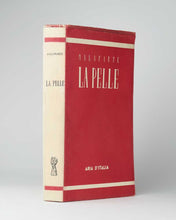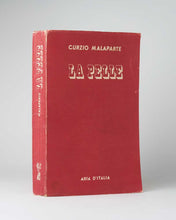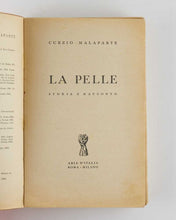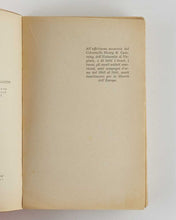
MALAPARTE, Curzio. La pelle. Storia e racconto. Rome-Milan: Aria d’Italia. 1949.
8vo. Original red wrappers printed in white, with the original red and white dust jacket; pp. [8] 11-416, [4]; jacket expertly repaired with spine supplied in high-quality facsimile, small creases to corners, extremities slightly rubbed with tiny loss to spine foot; internally lightly toned, but overall in excellent state.
First edition, first issue of Curzio Malaparte’s autobiographical novel on the Liberation of Italy, retaining the exceedingly rare dust jacket in the second state.
Dedicated to the memory of Colonel Henry H. Cumming (1905-1945) and “all the brave, good and honourable American soldiers … who died in vain in the cause of European freedom”, La pelle (The Skin) opens in Naples, recently liberated by the Allied troops, yet “in the throes of the plague”. Part memoir, part fiction, the book casts Malaparte himself as liaison officer with the Americans in a devastated and corrupt city. “Malaparte’s loyalties in La pelle oscillate: he seems to spend all of his time with the Americans, but portrays them both as they wish to see themselves and as they do not – clean, bighearted, and genuine, yet also clueless, corny, and ruthless”. His attitude towards the Italians is equally fraught: “they are ready to debase themselves at every turn. They are no more simple victims than the latter are simply victors” (Rachel Kushner).
The genesis of La pelle – a kind of sequel or counterpart to Malaparte’s preceding novel Kaputt – dates to 1946, when the writer began negotiating with the French literary scholar and editor Guy Tosi for a French edition of a novel provisionally entitled La peste (The Plague): “While Kaputt describes Europe under the Germans, La peste will depict Europe under the Allies, especially the Americans”. The appearance that same year of Camus’s La Peste, however, forced a reconsideration of the title. Between late 1947 and early 1948, some passages appeared in the French weekly Carrefour, provoking hostile reactions to its sadistic realism. To these concerns, echoed by his Italian publisher Bompiani, Malaparte responded in a trenchant letter of 30 March 1948: “But how can one give a picture of our ruin and of Europe’s without harshness? How could the rest of the book be understood – telling precisely of the slow rebirth of the sense of morality, of justice, of goodness, of pity, in us and in our liberators – if it did not begin with that inferno?”.
From April to June 1948, further extracts of the Italian text appeared in pre-publication form in the weekly Martedì, generally in reduced versions of what would later be included in book form. Between autumn 1948 and spring 1949, Malaparte’s relationship with Bompiani collapsed, while the project of Aria d’Italia took shape: a publishing house created by the French-born editor Daria Guarnati and Malaparte to issue his works. The “definitive edition” of Kaputt appeared at the end of 1948 under the imprint “Edizioni Daria Guarnati”. By February 1949, the project had expanded to encompass Malaparte’s complete works, to be published under the name Aria d’Italia.
The first printing of La pelle was released on 6 December 1948, followed almost immediately by numerous reprints. The second state of the dust jacket shows minor variants, most notably in the last line of the second column on the rear wrapper, where the imprint appears in two lines (whereas in the first state it had been given on a single line).
#2121551







